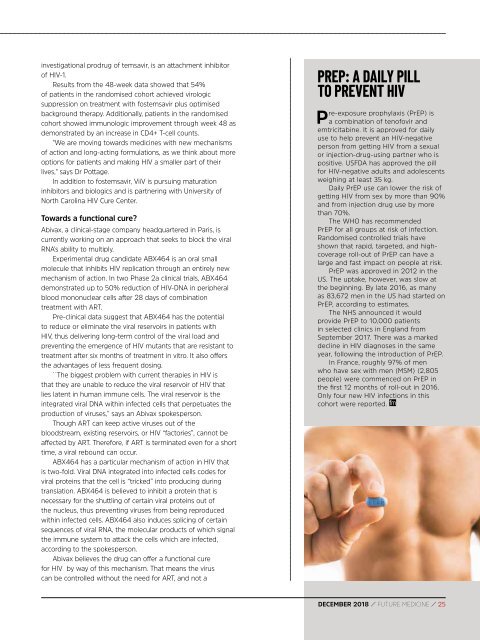FM DECEMBER 2018 ISSUE - digital edition
You also want an ePaper? Increase the reach of your titles
YUMPU automatically turns print PDFs into web optimized ePapers that Google loves.
investigational prodrug of temsavir, is an attachment inhibitor<br />
of HIV-1.<br />
Results from the 48-week data showed that 54%<br />
of patients in the randomised cohort achieved virologic<br />
suppression on treatment with fostemsavir plus optimised<br />
background therapy. Additionally, patients in the randomised<br />
cohort showed immunologic improvement through week 48 as<br />
demonstrated by an increase in CD4+ T-cell counts.<br />
"We are moving towards medicines with new mechanisms<br />
of action and long-acting formulations, as we think about more<br />
options for patients and making HIV a smaller part of their<br />
lives," says Dr Pottage.<br />
In addition to fostemsavir, ViiV is pursuing maturation<br />
inhibitors and biologics and is partnering with University of<br />
North Carolina HIV Cure Center.<br />
Towards a functional cure?<br />
Abivax, a clinical-stage company headquartered in Paris, is<br />
currently working on an approach that seeks to block the viral<br />
RNA's ability to multiply.<br />
Experimental drug candidate ABX464 is an oral small<br />
molecule that inhibits HIV replication through an entirely new<br />
mechanism of action. In two Phase 2a clinical trials, ABX464<br />
demonstrated up to 50% reduction of HIV-DNA in peripheral<br />
blood mononuclear cells after 28 days of combination<br />
treatment with ART.<br />
Pre-clinical data suggest that ABX464 has the potential<br />
to reduce or eliminate the viral reservoirs in patients with<br />
HIV, thus delivering long-term control of the viral load and<br />
preventing the emergence of HIV mutants that are resistant to<br />
treatment after six months of treatment in vitro. It also offers<br />
the advantages of less frequent dosing.<br />
``The biggest problem with current therapies in HIV is<br />
that they are unable to reduce the viral reservoir of HIV that<br />
lies latent in human immune cells. The viral reservoir is the<br />
integrated viral DNA within infected cells that perpetuates the<br />
production of viruses,'' says an Abivax spokesperson.<br />
Though ART can keep active viruses out of the<br />
bloodstream, existing reservoirs, or HIV “factories”, cannot be<br />
affected by ART. Therefore, if ART is terminated even for a short<br />
time, a viral rebound can occur.<br />
ABX464 has a particular mechanism of action in HIV that<br />
is two-fold. Viral DNA integrated into infected cells codes for<br />
viral proteins that the cell is “tricked” into producing during<br />
translation. ABX464 is believed to inhibit a protein that is<br />
necessary for the shuttling of certain viral proteins out of<br />
the nucleus, thus preventing viruses from being reproduced<br />
within infected cells. ABX464 also induces splicing of certain<br />
sequences of viral RNA, the molecular products of which signal<br />
the immune system to attack the cells which are infected,<br />
according to the spokesperson.<br />
Abivax believes the drug can offer a functional cure<br />
for HIV by way of this mechanism. That means the virus<br />
can be controlled without the need for ART, and not a<br />
PREP: A DAILY PILL<br />
TO PREVENT HIV<br />
P<br />
re-exposure prophylaxis (PrEP) is<br />
a combination of tenofovir and<br />
emtricitabine. It is approved for daily<br />
use to help prevent an HIV-negative<br />
person from getting HIV from a sexual<br />
or injection-drug-using partner who is<br />
positive. USFDA has approved the pill<br />
for HIV-negative adults and adolescents<br />
weighing at least 35 kg.<br />
Daily PrEP use can lower the risk of<br />
getting HIV from sex by more than 90%<br />
and from injection drug use by more<br />
than 70%.<br />
The WHO has recommended<br />
PrEP for all groups at risk of infection.<br />
Randomised controlled trials have<br />
shown that rapid, targeted, and highcoverage<br />
roll-out of PrEP can have a<br />
large and fast impact on people at risk.<br />
PrEP was approved in 2012 in the<br />
US. The uptake, however, was slow at<br />
the beginning. By late 2016, as many<br />
as 83,672 men in the US had started on<br />
PrEP, according to estimates.<br />
The NHS announced it would<br />
provide PrEP to 10,000 patients<br />
in selected clinics in England from<br />
September 2017. There was a marked<br />
decline in HIV diagnoses in the same<br />
year, following the introduction of PrEP.<br />
In France, roughly 97% of men<br />
who have sex with men (MSM) (2,805<br />
people) were commenced on PrEP in<br />
the first 12 months of roll-out in 2016.<br />
Only four new HIV infections in this<br />
cohort were reported.<br />
<strong>DECEMBER</strong> <strong>2018</strong> / FUTURE MEDICINE / 25


















